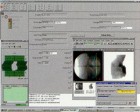 |
|
|
Latin American private healthcare institutions have launched a focused effort to install state-of-the-art radiation treatment systems. Like Chile's Catholic University, the Albert Einstein Hospital in Sao Paulo, Brazil has upgraded its capabilities with a Varian SmartBeam IMRT system. The National Cancer Institute of Brazil in Rio de Janeiro has improved its systems as well. Other Latin American cities with general hospitals upgrading their radiotherapy expertise include Bogota, Colombia; Quito and Cuenca, Ecuador; and Montevideo, Uruguay. Recently, five public hospitals in Mexico have added new radiotherapy departments using Varian systems and some have also selected Varian's VariSource brachytherapy system. The National Cancer Institute in Mexico City has added two linear accelerators.  VARiS software is at the core of Varian's fully integrated system for radiotherapy. It uses a relational database to control treatment equipment, manage patient information, and link clinical and business processes. It gives clinicians ready access to information needed for treatment decisions.
VARiS software is at the core of Varian's fully integrated system for radiotherapy. It uses a relational database to control treatment equipment, manage patient information, and link clinical and business processes. It gives clinicians ready access to information needed for treatment decisions.
|
 "We want to be on the frontier of treating patients with cancer."
"We want to be on the frontier of treating patients with cancer."An earnest man, Dr. Pelayo Besa makes this statement a promise as much as a desire. Dr. Besa is Chief of Radiation Oncology at Pontifica Universidad Catolica de Chile (Catholic University). He and his colleagues are partnering with Varian Medical Systems to form a Center of Excellence for radiotherapy in Santiago. "We want to offer state-of-the-art high quality medical care," he explains. Chilean cancer demographics closely resemble those of the United States, except for a higher percentage of gastric cancers. Until recently, cobalt radiation instruments served as the primary source for radiotherapy in Chile's public hospitals. Now that linear accelerators have received the World Health Organization's blessing as more effective in providing cancer therapy, Latin America's public hospitals have joined their private healthcare counterparts in setting up these units.
Catholic University trains more than one hundred Latin American medical doctors and many physicists, dosimetrists, and technologists each year. Its Centro de Cancer Nuestra Senora de la Esperanza, located in the medical school, has nearly four years of experience in using up-to-date conformal radiotherapy, having averaged more than 50 patients per day with this type of therapy. With its expertise in conformal therapy, Catholic University will soon provide training for physicians and medical researchers from various Spanish-speaking countries, including Spain. The Centro de Cancer is planning to expand its radiology department and to add a new multileaf collimator-equipped linear accelerator, including the software and ancillary equipment for SmartBeam IMRT. Dr. Besa says IMRT is an important advance in cancer treatment. "With this technique, we can focus the dose of radiation, increase it if needed, decrease the dose of radiation to the surrounding important organs, and achieve better outcomes for our patients." |
|
|


